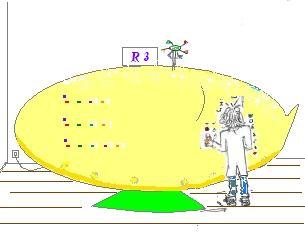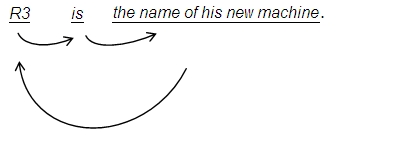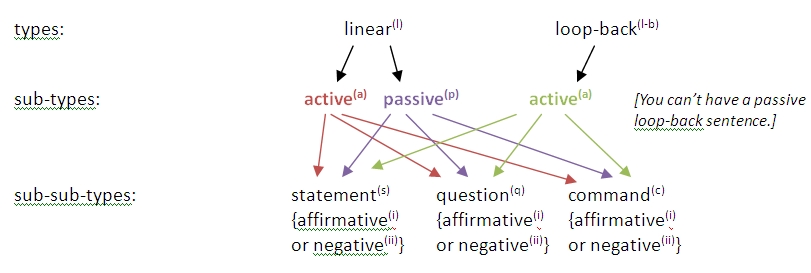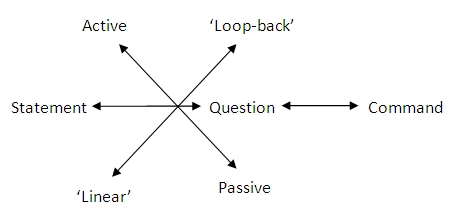
Here, so far, there has been a lot of review of conventional theories, followed by questioning and deconstructing, and thinking about fundamentals and criteria. This is good and valid, I feel. However, it is only the foundation work for creating something new and fresh and, hopefully, something better. So, let’s start that process now … finally. The starting point for this is to recognise that there are two key types of sentence in English and in many other source-related languages. What these are, we will come on to in a minute.
Why the ‘blind spot’?
But first, it amazes me that nobody to date, as far as I am aware, has particularly noticed or articulated this fundamental contrast of two basic sentence types – maybe it has been hidden from perception by the notion derived from Aristotle that all sentences have a subject (in a sense, the initial ‘topic’ of the sentence) and a predicate (what is said about the ‘topic’). This, as an idea, in effect conflates all sentences into being of one type. Admittedly, many have noticed that some sentences have an object, after the verb, and that others don’t and, instead, can have what is called a complement, after the verb, as in this contrast of sentences:
A) He watched the screenOBJECT for a while.
B) He was intriguedCOMPLEMENT.
However, an object is also considered to be a form of complement; so, once again, the available concepts and terminology have somehow blocked us from a possible awareness of there being two key sentence types at play in the language.
The two key types of sentence: the ‘linear’ and the ‘loop-back’
If one does an internet search along the lines of ‘what sentence types are there?’ One is generally presented with the answer that there are four: statements, questions, commands and exclamations. First off, an exclamation is not a variant sentence type: it’s either not a sentence (What a fool!), or it is a statement (You did that!) or a question expressed as a statement (You did what?!). Second, I would say that these are not superordinate sentence types but actually sub-types of sentence.
For my money, there are two key superordinate sentence types that can be categorised, above all, by their distinct semantic dynamic within the sentence. The first type, which I have previously (rather confusingly perhaps) referred to here as a type 2 sentence has a progressive/continuous dynamic within the sentence; each sentence part, each with its own function within the sentence, simply adds to the information in the previous part as shown here:
(A)

The second sentence type, which I have previously referred to here as type 1, has a progressive and then a recursive/circling/annulate semantic dynamic; the sentence part after the verb refers back to the part before the verb and adds information to that:
(B)

So, what shall we call these two sentence types? ‘Type 1’ and ‘type 2’ are not very transparent as names. I had thought of calling type 2 sentences ‘doing sentences’ and type 1 sentences ‘being sentences’. But, type 2 sentences can readily also describe states, as in:
(C)
![]()
and type 1 sentences can describe actions, certainly in terms of behaviour:
(D)

So, ‘doing’ and ‘being’ is not a successful typology for these two types. My feeling now is that they should be described by their internal semantic dynamic, so A and C are ‘linear’ sentences and B and D are ‘loop-back’ sentences. As we shall see, an awful lot flows from this fundamental contrast of sentence types. As we shall see, the synthetic grammar of the two sentence types is consistently different and what they can absorb from the analytic grammar is different. Also, much will become apparent that has been hidden in terms of the subtlety and shadedness of meaning that English achieves through playing across these two sentence types and in terms of the complex dynamic between the synthetic grammar and the analytic grammar.
It could be said that this is all quite esoteric. However, among other things operating within the language, this fundamental contrast of sentence types is fundamental to the way we think – it determines the way we think. The better we understand that, the better we can understand why we think as we do and the better we can understand why what people say to us affects us in the way that it does. This is all about making available to consciousness the unconscious awarenesses we have about language.
The ‘trinsic’ cline
At this point, and perhaps slightly as an aside but also to better characterise the two sentence types, I want to offer a possibly slightly fanciful idea about the the two types, the ‘linear’ and the ‘loop-back’. It occurs to me that there is, what one might call, a ‘trinsic’ cline from the extrinsic, at one end, to the intrinsic, at the other. In a way, linear sentences describing states look to be towards the extrinsic end of the cline; they describe a situation that someone or something is in but they don’t particularly describe anything intrinsic about that someone or something, as in these examples:
(E) He works in a shed.
(F) He has three cats.
(G) He has a plan.
(H) He likes solving problems.
Meanwhile, ‘loop-back’ sentences describing states look to be towards the intrinsic end of the cline, they tend to describe something that feels intrinsic about that someone/something rather than the situation that they are in:
(I) It looks like a yellow submarine.
(J) He is a scientist.
(K) He feels hopeful.
(L) He is excited.
We can position these sentences on the ‘trinsic’ cline thus:

Of course, one can argue about the position of the sentences on the cline. One could perhaps even suggest that there can be an overlap and that the ‘linear’ sentence (H), for example, should be slightly to the right and not to the left of the ‘loop-back’ sentence (I), but there does seem to be a clear tendency for each type of sentence to be more to one or the other end of the cline.
Sentence typology
I said above that, conventionally, sentence types are seen in terms of statements, questions, commands etc. and that these should be seen in fact as sentence sub-types. But, in fact, I think they should be seen as sub-sub-types, with the contrast between active sentences (where ‘something does something’) and passive sentences (where ‘something is done to something’) being intermediate between the ‘linear’/’loop-back’ contrast and the statement/question etc. contrast. Have a look at this diagram of the structure of sentence typology I am proposing here:
 So, for example:
So, for example:
l+a+s+i = a linear, active, affirmative statement: He pressed the ‘on’ button.
l+p+q+ii = a linear, passive, negative question: Hasn’t the machine been switched on yet?
l-b+a+c+ii = a loop-back, active, negative command: Don’t be impatient. (= ‘You should not be impatient.’)
But, within any categorisation system, what prompts a type to be seen as superordinate or subordinate to other types? That’s a good question! I would say that a type can be seen as superordinate if it has fewer options on its parameter than other types do on theirs; for example, the ‘linear’/‘loop-back’ contrast is superordinate because it has only two contrasts whereas the statement/question/command contrast has three options and, so, it is subordinate. ‘Ah‘, but you might say, ‘the active/passive contrast is only binary; should that not be, then, on a par with the linear/loop-back contrast?‘ I would counter that the active/passive contrast should be subordinate because it has an option theoretically of the passive ‘loop-back’ sentence, that is not possible in actuality. There is something of a process issue here: it is counter-intuitive to think that we decide to make a passive sentence and then that is blocked as an option when we realise we need to use a loop-back sentence; it seems more likely, and natural and intuitive, that the fact that we decide to use a loop-back sentence naturally blocks us from a passive use.
‘Ah‘, you might say, ‘but what about the affirmative/negative contrast, that has only two nodes of contrast and so should it not be higher in the hierarchy by your reasoning?’ I would say ‘No’. I added that contrast for a kind of completeness, but it is actually at an intermediate level between the synthetic and the analytic grammar; not and n’t work at the level of the phrase, a syntactic structure that works between the synthetic and the analytic; whereas, the table of types above is focused on a range of variables within the synthetic grammar.
Psychological reality?
Does the sentence typology table above have any psychological reality? I would say that it does. Why? It does because … well, because it would seem to reflect something about how we, unconsciously to some degree, conceptualise the language in our minds when we learn it and when we use it. But, when we talk and speak for example, do we work up and down the levels of types? That seems possible but it almost equates to an industrial manufacturing plant model, which feels limiting and clunky. If we use a computer model, then we could say that the mind works between the levels jumping rapidly between them much like a computer jumping between tasks when we have given it a number of tasks to complete before the previous tasks have been completed. Could it be that we organise the information in interconnected networks, much like a digital computer-hosted network? That is possible, but it is still working on an analogy with our conventional concrete realities.
Could it be that each level is actually operating more as a dimension in our thinking and feeling and in our language and we work within all the dimensions simultaneously, not just the synthetic grammar dimensions but also the analytic grammar dimensions, almost entirely unconsciously? By dimensions here, I don’t mean the space-time dimensions of theoretical physics (from Einstein, to Kaluza, to String theory and on) of course, but rather the conceptual dimensions of awareness and choice as they relate to the grammar. In terms of psychological modelling, we have here something that feels more profound – in actual fact, something almost like the microscopic, almost frantic world of quanta within quantum mechanics. This kind of multidimensionalism seems to be psychologically possible and could be presented, two-dimensionally, thus:

There is no hierarchy, that obviously, in the dimensional model of the linguistic mind, but maybe the mind somehow operates with both a hierarchical typology model and a multidimensional model in the same time.
But anyway, these are psychological modelling speculations and nothing can readily understand itself; the brain cannot; and, the brain and the mind are not necessarily one and the same; the grammarian cannot see the flame of the mind directly, but only the lights and shadows it creates on the wall of the perceivable.
And now?
And so, the next stage is to look at the functional categories within ‘linear’ sentences and, then, at those within ‘loop-back’ sentences. In this way, each type of sentence can be better characterised AND the nature of the semantic dynamic operating within each type better perceived.